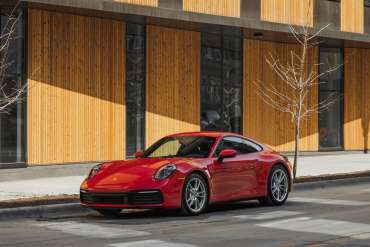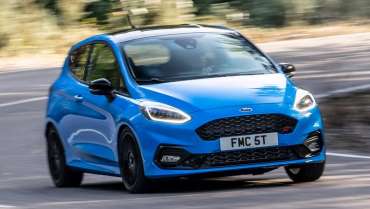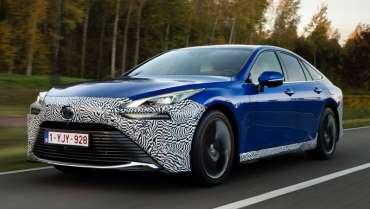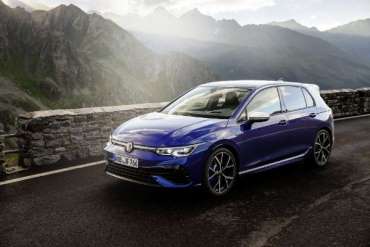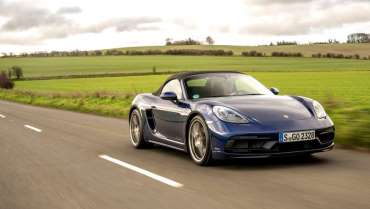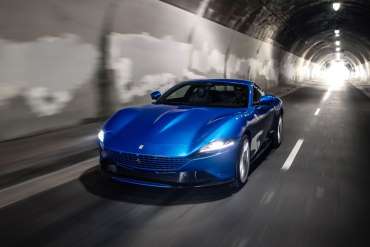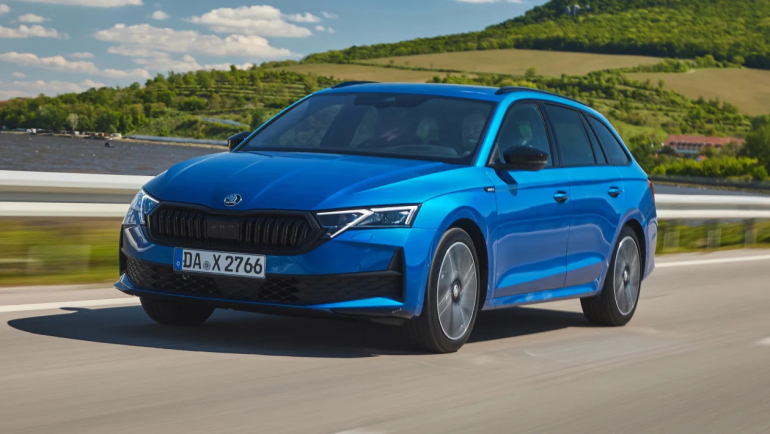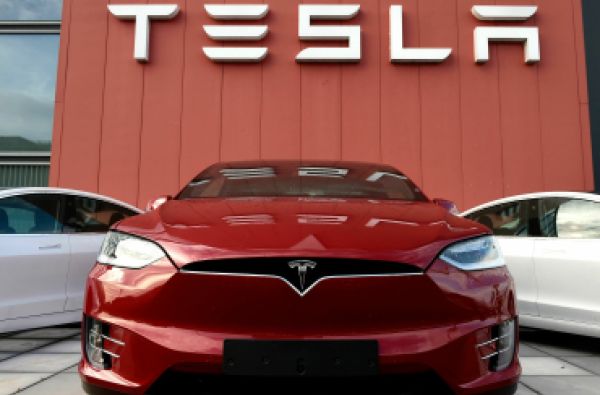
Worldcarblog.com
2021 Mercedes-Benz E-Class All-Terrain Full Review (VIDEO)
In March, Mercedes-Benz unveiled the 2021 E-Class All-Terrain Wagon complete with a handful of updates and confirmed that it is coming to the United States.
The high-riding version of the E-Class Wagon follows the same recipe of rivals like the Audi A6 Allroad and Volvo V90 Cross Country with features including an increased ride height and black body cladding. The E-Class All-Terrain also features a bespoke front grille and a distinctive skid plate. It all looks rather nice and the car was recently put through its paces by Autogefühl.
The example tested is the E450 4Matic All-Terrain. As such, it is powered by a 3.0-liter turbocharged inline-six with EQ Boost technology producing 362 hp and 369 lb-ft (500 Nm) of torque, while the 48-volt mild-hybrid system adds an extra 21 hp and 184 lb-ft (249 Nm) of torque, for a 0-60 mph (0-96 km/h) time in approximately 5 seconds.
Like the regular E-Class, the interior of the 2021 All-Terrain is extremely nice and filled with loads of impressive technologies. A good portion of the interior review focuses on the MBUX infotainment system that houses features like the ambient lighting and massage seats.
The review then shifts to the Autobahn. Thee car is put through its paces at cruising speeds of 124 mph (200 km/h), with the presenter noting that it remains stable and is very quiet.
{vembed Y=Cfb25cgEJGs}
Source: mercedes-world.com
Tested: Base 2020 Porsche 911 Is a Worthy Six-Figure Sports Car
Porsche's entry-level 911 doesn't have a big horsepower number, but it has the performance goods to justify its price.
12/1/20 UPDATE: This review has been updated with test results for a 911 Carrera equipped with the automatic.
This is very likely the least expensive new Porsche 911 you'll ever lay eyes on. At $106,290, it has a mere $7540 in options, which, if you don't believe is a picture of restraint, go spend a few minutes on Porsche's online configurator. This car had just four add-ons: a Sport Exhaust system ($2950); the Sport Chrono package, which includes launch control ($2720); Lane Change Assist, which most other automakers call blind-spot detection ($1060); and Sport Seats Plus ($810). Let's see if the extreme low end of the 911 lineup lives up to six-figure sports-car expectations.
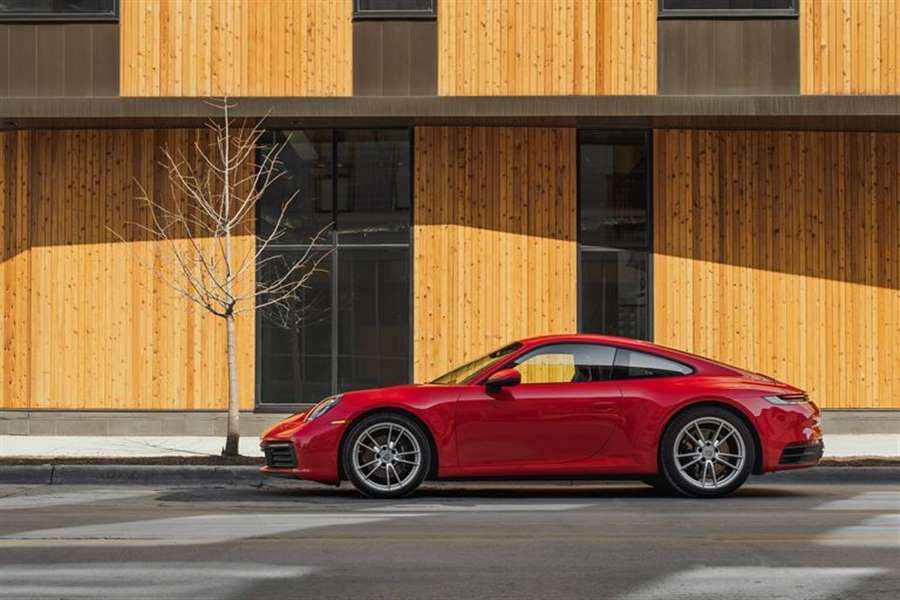
A peak horsepower figure of only 379 from its twin-turbo 3.0-liter flat-six is not a great start toward credibility. A V-6 Camry also has a power figure that starts with a 3 yet costs a third as much, and there are many examples of more for less when it comes to maximizing underhood output.
HIGHS: Legit performance, curb weight has been kept in check, outstanding highway fuel economy.
But the 911 is deceptive. In the new-for-2020 992-generation 911, an eight-speed dual-clutch automatic transmission—PDK in Porsche parlance—replaces the previous seven-speed unit. Its general brilliance in terms of both quickness and smoothness is familiar, although the car we drove did bobble a couple of shifts before it was fully up to temperature. Also familiar is Porsche's simple and extremely effective launch-control function, which revs the engine to 5000 rpm before dropping the hammer and perfectly slipping the clutch. The engine speed never drops below 4000 rpm as the car makes a smooth and very swift departure. And it is happy to repeat this launch-toward-the-horizon routine just as often as you'd like. Our test car made consistent, repeated passes of 3.2 seconds to 60 mph and 11.5 seconds through the quarter-mile, which are 0.1- and 0.3-second quicker, respectively, than the 2017 911 Carrera with the PDK that we previously tested. Those results also make the base car just 0.3-second slower than the 443-hp Carrera S in both measures.
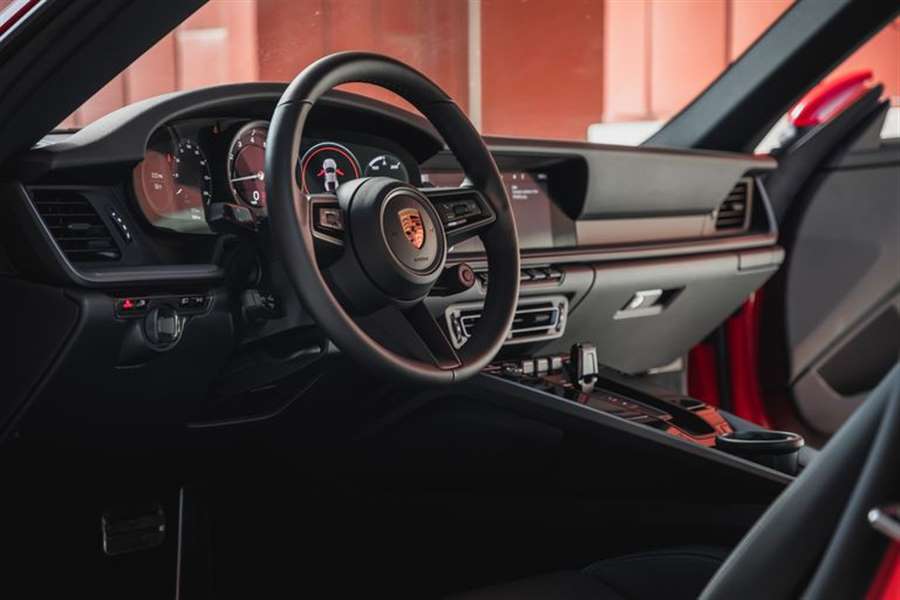
Besides the phenomenal performance bargain that is the latest Chevrolet Corvette, any sports car that outruns the 911 costs substantially more. One reason for its more-with-less performance is that the 911 has kept its weight gain in better check than many of its peers. This car weighs just 57 pounds more than before, making it roughly 300 pounds lighter than today's Corvette. Despite adding inches and turbos, the 911 doesn't weigh even 100 pounds more than the 15-year-old 997-generation cars.
Excellent Fundamentals
In addition to straight-line acceleration, the fundamentals of a great sports car are all here. The 911's buildup in steering effort is just right, and it's constantly atwitter with road-surface information. This is electrically assisted steering done properly. Interestingly, the lid of the center console bin is surprisingly talkative, too. Resting an elbow there intercepts the communicatory tingles of what the car happens to be trampling over at the moment. The 911 also continues to prove the point that seats don't need a lot of adjustments. The headrest on our lightly optioned car is fixed, and there's manual fore-aft, and power adjustment for height and seatback angle and bottom height. That's it, and yet they fit both the short and the tall commendably well. The additional bolstering of the $810 Sport Seats Plus option is soft enough to not be restrictive nor fatiguing on longer drives. Brake feel is nigh on perfect, with telepathic responses and no lost motion. Aided by its rear-heavy weight distribution, the 911's stopping distances of 139 feet from 70 mph and 277 from 100 mph are up there with the best of the best.
LOWS: Base interior has some cheapness, even lightly optioned 911s cost six figures.
We appreciate that changing the 911's drive mode doesn't cause the steering effort or ride control to go overboard in either direction. The tweaks in its calibrations are subtle, and there isn't a bad mode. The only element that makes us roll our eyes is the three artificial-sounding pops that accompany a lift of the throttle in Sport mode, which disappear in Sport Plus. Both sporty modes raise the idle speed from 600 to 800 rpm for a little extra responsiveness. Those who listen for it can hear the turbo hiss from the blow-off valve, but this latest twin-turbo 3.0-liter retains the gritty flat-six undertones that we love, no doubt emboldened by the optional Sport Exhaust on our car. Every 911 has a little piece of the 9000-rpm GT3 rock.
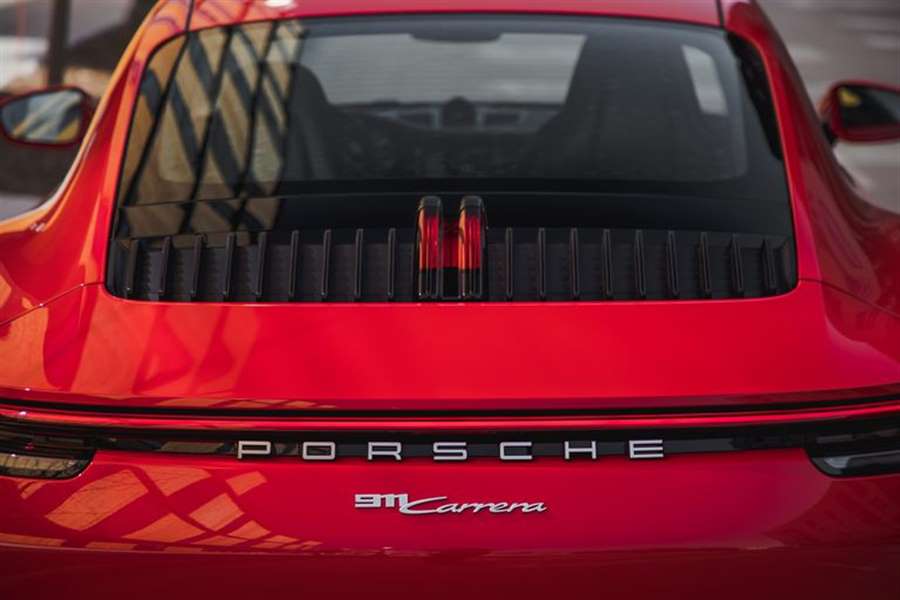
As far as sports cars go, the 911's ride smoothness is reasonable. But on under-maintained roads, it can get clompy over bumps and pavement seams, especially with the narrower sidewall and higher-pressure rear tires. Remember that the 992 went to a staggered-diameter wheel arrangement with 19-inch fronts and 20-inch rears as standard and available 20/21s.
When not wailing, the engine settles below 1800 rpm at 75 mph, allowing for an outstanding 33 mpg on our highway fuel-economy loop, the best result from any 911 we've ever run. That's 2 to 3 mpg better than its 992 S and 4S siblings and also 3 mpg better than the best previous-gen 991 (a Carrera 4 automatic). Despite the improved real-world fuel economy, for some unknown reason the EPA values took a huge hit in the 992 generation, dropping from a 30-mpg highway estimate to 24 for a base car with the automatic transmission.
Entry-Level Innards
Base also means a uniformly grained black interior, which, although soft to the touch, is not as convincing in the six-figure space as are the leather-upgrade options that start at $2840. The only thing breaking up the monotony is the knurled gray trim extending from the door handle and on the ridge under the center screen running across the dash.
Surrounding the shifter is a large area of stark piano-black trim, which no amount of money can fix, as even the $204,850 Turbo S doesn't fill in any of its blankness. This is a carryover from the four-door Panamera, which populates this area with controls. There are window-switch blanks, too, as Porsche is deploying shared hardware across car lines with different door counts. A big, beautiful mechanical tachometer remains in the middle of the 911's now otherwise digital gauge cluster. But we miss the depth of the previous mechanical gauges that flanked it.
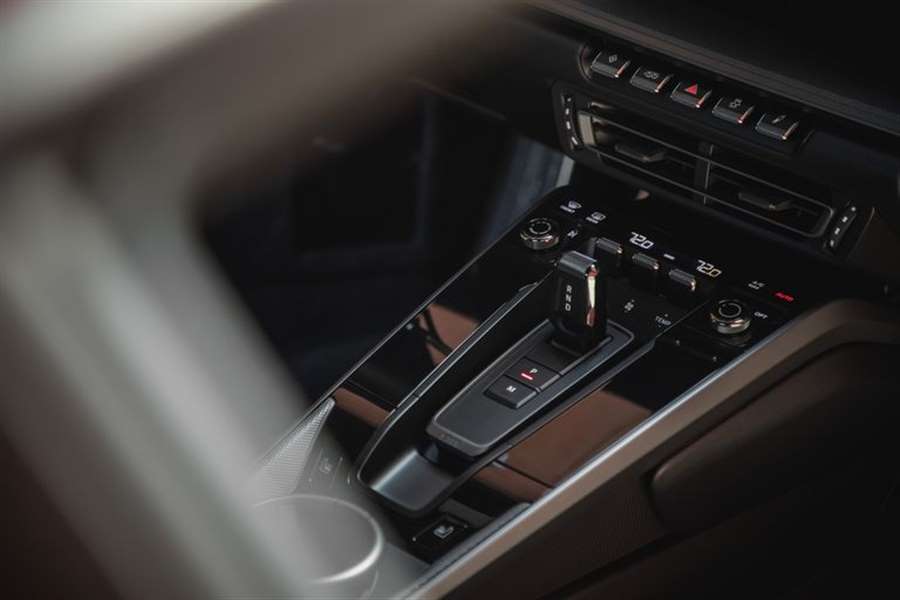
Also new on the 992 are power door handles that pop out to facilitate opening. Our early-build car, however, didn't have the $550 Comfort Access option that prompts them to present themselves automatically when you approach the car. Having to get the fob out of your pocket to actuate the handles and then squirreling it right back away because keyless ignition is standard is the kind of slight annoyance that we think people who plunk down $100K on a car will find obnoxious. Porsche apparently agreed, as it made Comfort Access standard mid-way through the 2020 model year.
Of course, the 911 retains its familiar small rear seats, an all-important point of justification to wannabe sports-car buyers with small children. That means in addition to outperforming and outdriving most of its peers, it also outseats them. Yes, even the base 911 resoundingly stacks up as a six-figure sports car. Although we would feel compelled to upgrade the interior a little if it were our money.
Source: caranddriver.com
Ford Fiesta ST hatchback review
"Fast and fun yet practical and economical, the latest Ford Fiesta ST is as great a hot hatch as ever"
If you’re in the market for a small hot hatchback you’d be forgiven for being a little overwhelmed. A worthy shortlist of talented candidates includes the Peugeot 208 GTi, Suzuki Swift Sport, Volkswagen Polo GTI and MINI Cooper S – but the Ford Fiesta ST, for many the traditional class leader, was notable by its absence after the previous-generation model went out of production in 2017. Thankfully, May of 2018 saw the return of an all-new version.
Ford has pulled out all the stops to make sure the latest Fiesta ST can reclaim its crown. There’s a new 1.5-litre, three-cylinder turbocharged engine that produces 197bhp, giving the ST a 0-62mph time of 6.5 seconds – thanks in part to an overboost feature. Despite this performance, economy is respectable; the car’s engine can shut down one of its three cylinders at lower engine speeds to save fuel while you're cruising, helping it return over 40mpg.
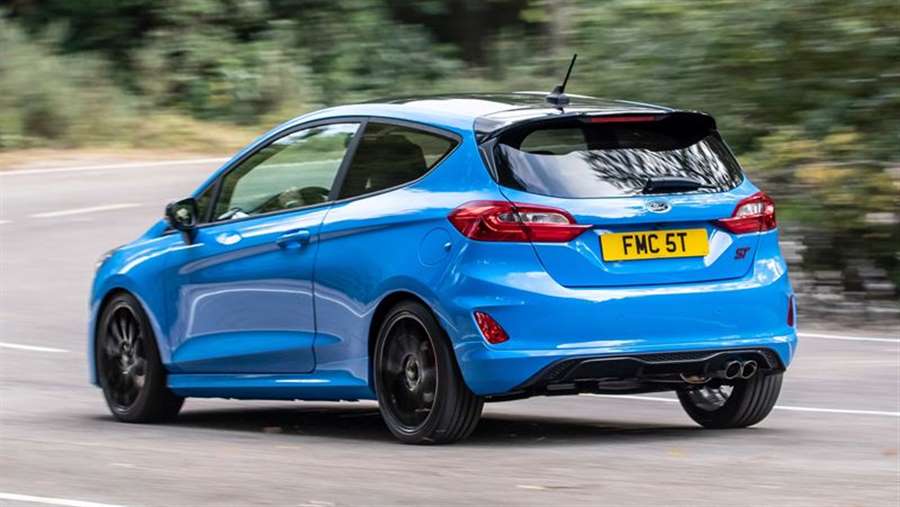
During more spirited driving, the short-shift six-speed manual gearbox can be ‘flatshifted’, meaning you don’t have to take your foot off the throttle when changing gear. Launch control is also included if you specify the optional Performance Pack, along with a limited-slip differential to improve traction and gear shift lights.
Hot hatchbacks aren’t all about straight-line speed though, and the Fiesta ST really comes alive when tackling a twisty road. Fast, accurate, communicative steering and an impressive suspension setup with clever dampers mean the ST feels poised and lively through corners, with plenty of grip. The optional limited-slip differential and standard torque-vectoring make it easy to put power down out of corners, while the car’s electronic stability control system can be backed off gradually via selectable driving modes if you don't want them to intervene prematurely on a race track.
A Performance Edition version is also offered, adding lightweight alloy wheels and coilover suspension that can be adjusted by the owner. It comes in a bright orange paint and costs around £2,500 extra. For most owners, the standard ST is better value but the Performance Edition is the ultimate version of the car from a handling perspective.
The good news is that all of this potential for fun has not come at the expense of day-to-day usability. The Fiesta ST loses none of the standard car’s space and practicality, with the same interior layout and identical boot space. Unlike some rivals, both three and five-door versions are available too. The ST also benefits from the same five-star Euro NCAP safety rating as the standard Fiesta. Provided you can afford the higher running costs, there’s no reason why the Fiesta ST couldn’t serve perfectly well as everyday transport.
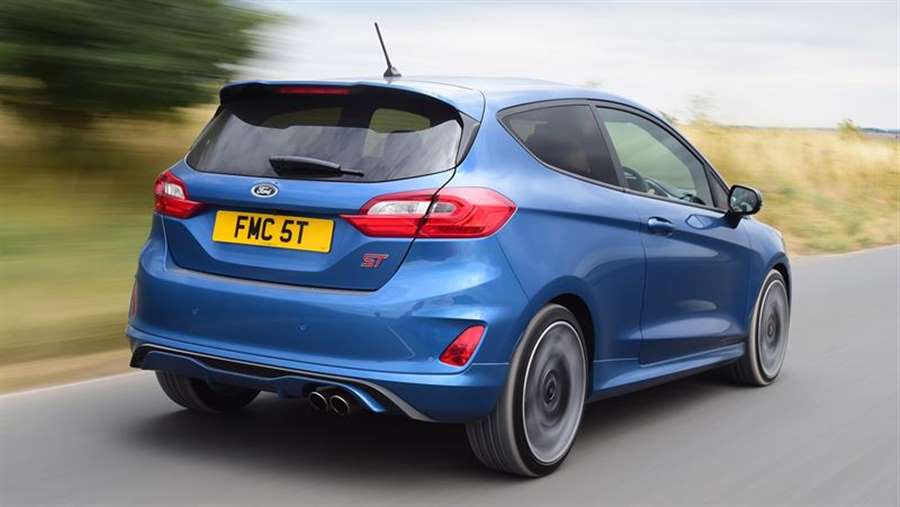
The Fiesta ST doesn’t give much cause for complaint, but those who value pliant suspension and relaxed cruising may find it slightly too firm, especially over rougher surfaces. While the car’s sporty suspension actually does a fine job of keeping the driver in control over undulating roads, ride quality does suffer slightly even in the most relaxed driving mode.
If you don’t mind a harder, less relaxed edge to your motoring experience though, the Ford Fiesta ST is one of the best cars in its class. It’s more fun to drive than the Volkswagen Polo GTI, faster and more engaging than the latest Suzuki Swift Sport, and more than a match for the enthusiast-favourite Peugeot 208 GTi.
For a more detailed look at the Ford Fiesta ST, read on for the rest of our in-depth review.
Ford Fiesta ST hatchback - MPG, running costs & CO2
Clever engine technology means the Ford Fiesta ST’s running costs are relatively sensible
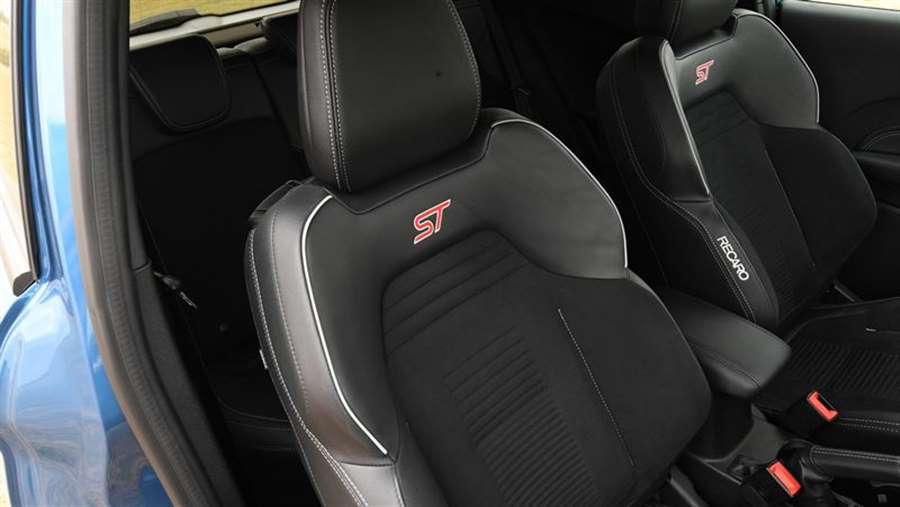
Gone are the days when choosing a performance model means taking a massive hit when it comes to running costs. Today’s hot hatches are designed to balance performance with efficiency and the Ford Fiesta ST is no exception. With an engine that can shut down one of its three cylinders when not required (the first time this technology has appeared on a production three-cylinder engine), the ST can return decent fuel economy and emissions figures despite its considerable performance. The 2.0-litre VW Polo GTI is almost as efficient though, presumably because its larger engine isn’t working as hard.
The Ford Fiesta ST’s 1.5-litre turbocharged three-cylinder petrol engine is powerful, but thanks to some clever technology it manages to be relatively frugal. Between 1,200 and 4,500rpm, or at less than half throttle, the ST’s engine can shut down one of its three cylinders to improve economy by up to 6%, according to Ford. In our experience, the switch between three and two-cylinder drive (and back again) is almost imperceivable.
Ford quotes an average fuel economy figure of 40.4mpg and CO2 emissions of 158g/km. Road tax will cost £150 per year. Company-car users will have to contend with a high Benefit-in-Kind rate. During our time with the car, we averaged just over 38mpg across several hundred miles of motorway and town driving.
It’s worth remembering that although the ST is derived from humble stock, its consumable parts will cost more to replace. Its larger brakes and sticky Michelin Pilot Sport tyres will be more expensive to replace when compared to other Fiesta models.
Insurance group
The ST is the most expensive Fiesta variant to insure, sitting in group 28 out of 50, or group 30 if you buy the Performance Edition.
Warranty
As with all Fords, the Fiesta ST comes with a three-year/60,000-mile warranty as standard. This can be extended to a four-year/80,000-mile or a five-year/100,000-mile plan at a price, though it is not yet clear if prices will command a premium over the standard car. As it stands, an extension to four years is quoted as £190 for the standard Fiesta, or £350 for a five-year plan. Roadside assistance is also included for one year.
Servicing
Customers can choose a Ford Protect Service Plan – a one-off payment plan that covers scheduled servicing, replacement vehicle hire and more. Higher-mileage drivers can opt for Ford Protect Service Plan Plus, which adds additional covered replacement parts, like shock absorbers, exhaust silencers and brake pads.
Ford Fiesta ST hatchback - Engines, drive & performance
The Ford Fiesta ST lives up to its reputation; it’s both fast and great fun to drive
Fans of the previous Ford Ford Fiesta ST won’t be disappointed with the latest model, despite its numerous mechanical changes; this is a hot hatch that does everything right. Its smaller engine lacks the character of the four-cylinder found in its predecessor, but there’s still more than enough low-down punch, an eagerness to rev and a suitably sporty exhaust note. Some rivals offer a more traditional four-cylinder engine, but those looking for great performance will not be left wanting by the Ford’s three-cylinder – which itself is lighter and therefore helps towards a better-handling machine.
Add the optional Performance Pack (costing around £900) and you’ll benefit from a limited-slip differential (LSD) made by specialist company Quaife; this helps the ST put its power down more convincingly, especially when exiting corners, limiting excessive wheelspin. Launch control also comes as part of the pack, making fast getaways a breeze, along with shift lights to let you know when best to change gear.
Add the optional Performance Pack (costing around £900) and you’ll benefit from a limited-slip differential made by specialist company Quaife; this helps the ST put its power down more convincingly, especially when exiting corners, limiting excessive wheelspin. Launch control also comes as part of the pack, making fast getaways a breeze, along with shift lights to let you know when best to change gear.
Ford Fiesta ST petrol engine
The Ford Fiesta ST is powered by a 1.5-litre EcoBoost petrol engine with three cylinders, one turbocharger and plenty of power - 197bhp, plus extra low-down power when the standard overboost feature kicks in. The 0-62mph sprint takes 6.5 seconds and the car’s top speed is 144mph. The engine feels strong, producing a suitably rorty exhaust note that’s helped along by Ford’s Electronic Sound Enhancement, which uses the car’s stereo to further improve the sound. Select Sport or Track modes and the car’s exhaust will pop and crackle when you lift off the accelerator.
The only real drawback of the car’s switchable modes is the location of the switchgear, which is located low down by the gearstick. This can make cycling through the various modes a bit fiddly on the move but it does become easier with practice.
The previous Fiesta ST was more keen to rev to its redline, whereas the new model’s three-cylinder doesn’t feel like it needs to be revved past 5,500rpm – something that owners of the old car might miss. However, keen drivers will enjoy the ST’s delightful short-shift six-speed gearbox, which comes complete with a 'flat-shift' feature. Simply keep your right foot flat to the floor on the accelerator pedal and change gear using the clutch as usual; the car will automatically hold the engine on a limiter between gearchanges. However in our experience the result doesn’t feel too kind to the clutch, so we doubt most owners will use it in practice.
Ford Fiesta ST hatchback - Interior & comfort
The Ford Fiesta’s interior gets a sporty makeover, but outright comfort is not a priority
Those familiar with the standard Ford Fiesta will recognise most of the ST’s interior; it’s more or less business as usual, save for a few sporty touches. Chief among these are a set of very supportive Recaro sports seats (with an even more adjustable version as an option), which do a great job of holding you in place during fast cornering. The driving position is excellent, which is more than can be said of some of the Fiesta ST’s closest rivals, which often sit the driver too high up.
The Fiesta ST is more refined than ever before, but don’t expect this hot hatch to be the last word in comfort and relaxed cruising. The car’s sporty setup means that it rides fairly firmly; this can get uncomfortable over particularly rough tarmac at higher speeds, but generally the ST feels poised and controlled rather than pliant and cosseting. The car feels slightly fidgety on some roads, but that edge is exactly what many driving enthusiasts may miss from some of the ST’s rivals.
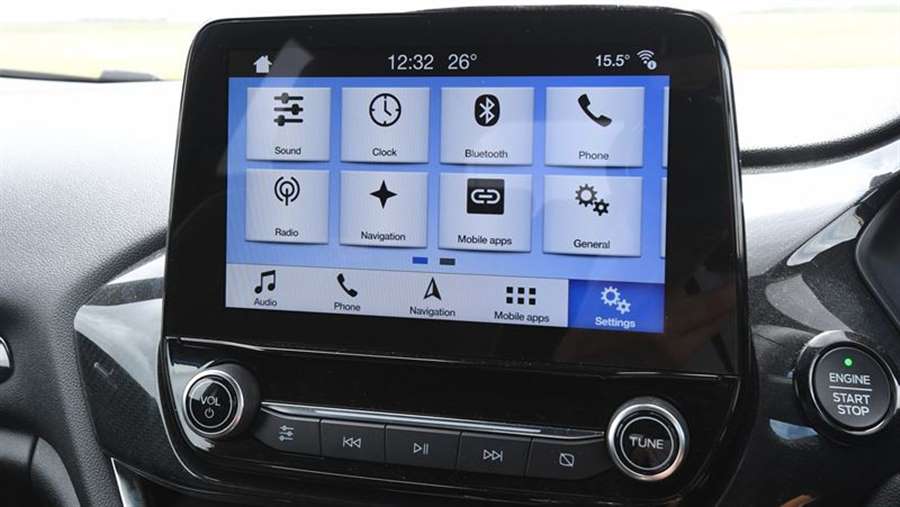
Ford Fiesta dashboard
The ST’s dashboard is carried over wholesale from the standard Ford Fiesta, albeit with a few small changes. Carbon fibre style trim, a flat-bottomed ST-badged steering wheel and a metallic-finished gearlever all feature, while optional shift lights sit in the dial cluster.
Ford Fiesta ST hatchback infotainment display20
Build quality is good and materials are generally of a decent quality but neither are a match for the VW Polo GTI. It's a big improvement on the older model, though, with much more impressive tech. Most of the changes for the Fiesta ST Edition are mechanical but it does get unique blue stitching inside, along with some carbon-fibre-effect trim. There's also a new steering wheel with a shortcut button for the Sport driving mode.
Equipment
There are two trim levels to choose from: ST-2 and ST-3. There's a comprehensive list of standard equipment, including ST-specific styling inside and out, sports suspension, Ford’s SYNC 3 infotainment system with DAB radio, Apple CarPlay and Android Auto functionality, cruise control and Ford’s ‘NCAP Pack’, which includes lane-keep assist and a speed limiter.
The ST-2 trim also includes climate control, heated seats, blue seatbelts, a B&O Play stereo and a larger eight-inch infotainment screen are all added. Top-spec ST-3 versions get the largest 18-inch alloys, red brake calipers, sat nav, automatic wipers, an auto-dimming rear view mirror and a suite of driver assistance systems that includes traffic sign recognition, automatic high-beam headlights and driver alert.
Options
There are a few good-value options available for the Fiesta ST. Enthusiastic drivers would do well to choose the aforementioned Performance Pack for its limited-slip differential, launch control and shift lights for around £900; LED headlights and a Driver Assistance Pack are also good additions for £500 and £550 respectively. A panoramic sunroof costs £700.
Technology
Save for its ST-specific drive-mode selection functionality, the SYNC 3 infotainment system featuring in the sportiest Fiesta is as good as ever. The system’s screen positioning may look like a bit of an afterthought but it’s great to use; pinch-and-swipe gestures are recognised and the system’s wide range of functions means there are far fewer buttons than were found inside the previous Fiesta ST.
Ford Fiesta ST hatchback - Practicality & boot space
The Ford Fiesta ST’s extra performance hasn’t dented its practical supermini credentials
Put simply, the Fiesta ST is no less practical than the more ‘sensible’ Fiesta models. There’s ample space in both three and five-door models, meaning it’s as family friendly as a car of this type can be – the rear doors on five-door versions open particularly wide too. Boot space is similarly unaffected.
Ford Fiesta ST interior space and storage
Occupants of the front seats get the best deal in the Ford Fiesta ST, as its excellent Recaro sports seats are supportive, adjustable and comfortable. Legroom in the rear is much the same as standard versions, meaning there’s about as much space as you’d find in the back of a Polo GTI. Headroom is still an issue as in other Fiestas; taller passengers are best carried up front.
Ford Fiesta ST hatchback boot20
The same array of cubbies features on the ST as on the standard Fiesta; there’s a glovebox that’s 20% bigger than in the old model, while a one-litre storage bin can be found in the centre console. Each door pocket can carry a 500ml water bottle with ease.
Boot space
The Fiesta ST is exactly the same as other models in the range when it comes to the boot, and that’s no bad thing. There’s a wide tailgate that opens to reveal a 292-litre boot; fold the rear seats and this expands to 1,093 litres. As with other Fiestas, an optional variable boot floor will help you make the most of this extended space or to store smaller items separately.
Ford Fiesta ST hatchback - Reliability & safety
The Ford Fiesta ST is just as safe as the standard car, though reliability is still relatively unknown
Thanks to its fairly recent arrival on the market, there’s precious little ownership data available for the new Ford Fiesta, never mind the sporty ST model. Its impressive safety credentials have been verified, however, with a five-star rating from Euro NCAP.
Ford Fiesta ST reliability
As stated above, the new Fiesta is still a recently launched model, so judging its long-term reliability isn't really possible. However, the standard Fiesta did enter our 2020 Driver Power survey in 71st place, low down in the rankings of the top 75 UK models with 17.3% of owners reporting one or more faults in the first year. It's a worrying result for Ford, suggesting the quality issues of previous years have not yet been fully resolved.
Ford finished in 24th place from 30 car makers in our 2020 brand survey, with owners complaining of poor exterior build quality and that boot capacity could be more generous. It wasn’t all bad news though, with owners praising the ride quality and handling of their cars. Overall, 15.6% of owners reported a fault in the first year of ownership.
The previous generation ST sold well and did not suffer from any particularly serious ailments; hopefully the latest car will continue in the same vein.
Safety
The Ford Fiesta ST benefits from the standard Fiesta’s five-star Euro NCAP rating. This was broken down into adult and child occupant protection ratings of 87% and 84% respectively, while a rating of 64% was given for pedestrian protection. The Fiesta’s 60% driver assistance rating is only average, but there are a number of systems that come as standard on certain ST models that don’t feature further down the Fiesta range, including lane-keep assist, traffic sign recognition and driver alert. Optional LED headlights and a blind-spot monitoring system are options worth adding to make your Fiesta ST as safe as possible.
Source: carbuyer.co.uk
New Toyota Mirai prototype review
We get behind the wheel of a prototype version of the second-generation Toyota Mirai hydrogen fuel cell car
Verdict
Disregarding the fuel cells beneath its bonnet, the Mirai is up there with ‘normal’ luxury saloons for the suave way it goes down the road. More than that, it’s a fantastic showcase for Toyota’s increasingly efficient and affordable hydrogen tech. Sadly it’s still teeth-suckingly expensive next to ICE alternatives, and is likely to remain a niche corporate purchase for a while yet. But with hydrogen cars this good on the market, the infrastructure surely can’t be far behind.
The development of hydrogen fuel cell vehicles (HEVs) has been stuck in a chicken and egg debacle for many years now. Which comes first – the cars or the infrastructure?
Given that there are currently 14 hydrogen filling stations in the UK, despite the fact that there have been two hydrogen fuel cell vehicles available (albeit at prohibitive cost) on sale over here in the shape of the Hyundai Nexo and Toyota Mirai, it looks like the car is going to have to come first.
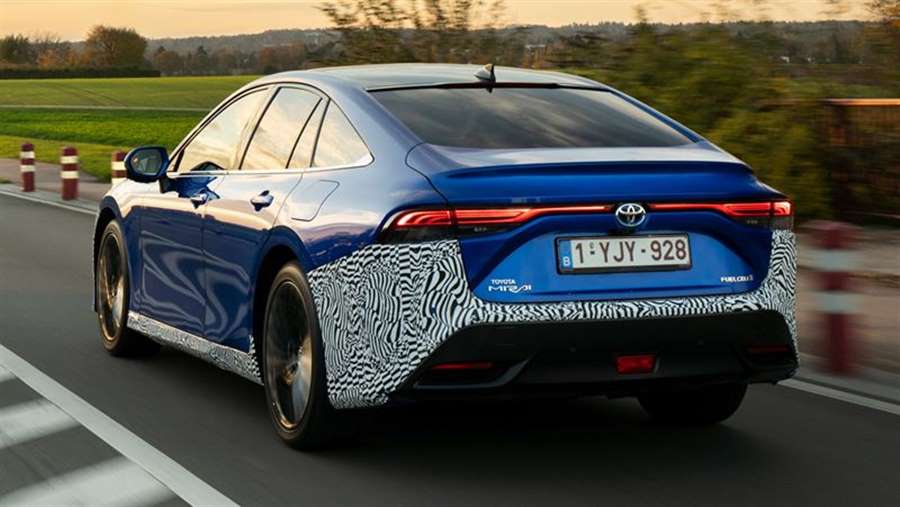
So here is Toyota’s latest effort to further the hydrogen cause; the all-new, second generation Mirai. This is an early pre-production model but, with the car now based loosely on a Lexus LS platform, the Mirai has become rather suave and dashing in an understated kind of way.
Unless you were looking for the tell-tale badges on the outside, you’d never know that a fuel-cell stack sits beneath its bonnet, which in turn drives a 180bhp electric motor mounted on the rear axle. In the middle of all that sits three T-shaped hydrogen tanks that can take 5.6kg of hydrogen – the equivalent of 142.2 litres, giving an estimated driving range of around 500 miles between fill-ups (which take no longer than in a petrol or diesel car).
In practice, the serene-feeling new Mirai is a revolution to drive compared to its predecessor. The steering is light and, while far from precise, feels direct and predictable. Ride comfort is truly exceptional, too. There’s quite a bit of pitch and heave as the sizeable body (which roughly splits the difference between a BMW 5 Series and 7 Series) shifts about, but it’s well controlled and unobtrusive, not to mention worth living with for the pillowy way the Mirai rolls over scruffy surfaces.
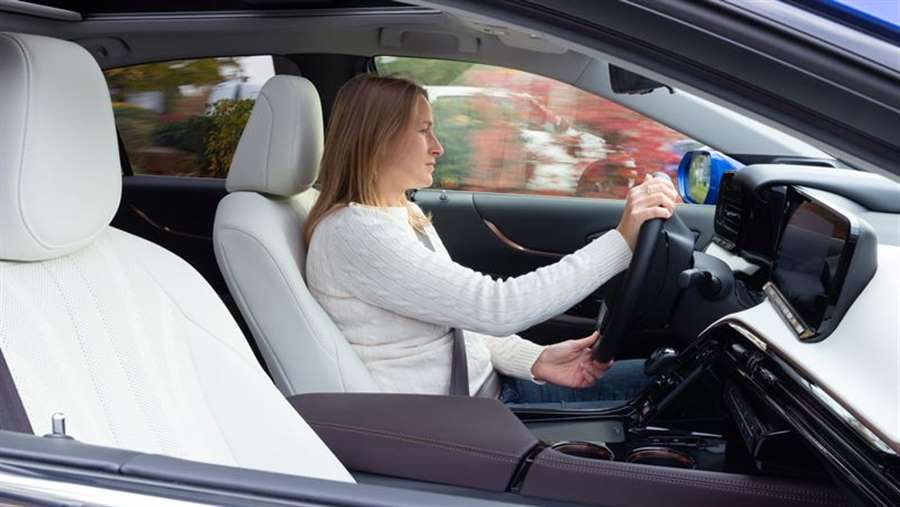
This comfort, and the near silent, seamless power delivery are the defining characteristics of the Mirai’s newfound luxury ambience. A hydrogen fuel cell vehicle is still driven by an electric motor so you get the same continuous, uninterrupted stream of acceleration that is becoming familiar with normal battery EVs. There’s no discernible noise at all from the fuel cells as they putter away mixing hydrogen from the fuel tanks and oxygen from the atmosphere, to create electricity for power, and a small amount of water as the only bi-product, which you can purge by pressing a tempting ‘h2o’ button just next to steering wheel.
This powertrain is quiet and refined by its very nature, then, and in the Mirai it’s cosseted in a car that’s been given all the refinement treatment you’d expect of a top-notch Lexus. But for a distant burr of wind and tyre rush, noise and vibration in the Mirai is virtually indiscernible.
Even the interior, which is stuffed with high quality leather, chunky armchair-like seats, a huge touchscreen resplendent with Apple CarPlay and Android Auto as well as factory-fit nav, feels befitting of a limo-class car despite the odd cheaper-feeling switch and panel finish. There’s luxurious amounts of room to stretch out in the back seats, too.
The only thing about the Mirai that isn’t luxurious is the performance. It doesn’t feel as lazy as the 0-62mph time of 9.2 seconds suggests; there’s decent pick up even from middling speeds to motorway speeds, but for a big, plush car – environmentally minded or not – it’d be reasonable to expect better performance. Toyota maintains that it can put a more powerful motor in fairly easily, but with efficiency and range the chief priority with the Mirai, engineers stuck with stately rather than sporty performance.
As it is, it’s really rather lovely to drive in a big, wafty, almost eerily quiet fashion. But more importantly it represents a host of incremental gains that could help to make hydrogen a feasible solution for mainstream vehicles.
The fuel cells are now lighter and more efficient, and the fuel tanks aren’t just bigger, they’re made of a new, lighter and more affordable carbon fibre. More than that, with these gains factored in and Toyota’s increasingly refined hydrogen fuel cell production line, the company can now punch out a hydrogen fuel cell in a matter of seconds - and for usefully less money than before.
Having said that, the Mirai still may not even be available as a normal retail purchase. List prices are yet to be confirmed, and while it’s expected to be more affordable than before, you’ll probably still have to find around £65,000 – or a monthly lease payment (the previous generation cost £750 per month) is also a likely option.
That’s cheaper, yet a million miles from cheap. Even without the extreme limitations of the hydrogen charging infrastructure, being able to get an Audi A6, BMW 5 Series or otherwise for some £20,000 less makes the Mirai, well… Let’s just say it’s hard to recommend. Even so, that shouldn’t detract from the fact that it is, by any measure, lovely to drive and – most importantly – a superb showcase for hydrogen fuel cell technology.
Source: autoexpress.co.uk
Golf R 2022 Presented
The Volkswagen Group has introduced a new sports iteration of the popular model ...
We start with the powertrain, because that’s what VW has been working on the most. The 2022 Golf R has a turbo 2.0-liter four-cylinder engine that produces 315 hp and 420 Nm of torque. That’s an increase of 27 hp and 41 Nm, which doesn’t sound like much, but it means a lot in terms of acceleration and performance.
In the United States and Canada, the engine will be paired with a standard six-speed manual transmission while the European version will be offered exclusively with the DSG. Regardless of the selected transmission, all models will be equipped with an all-wheel drive system.
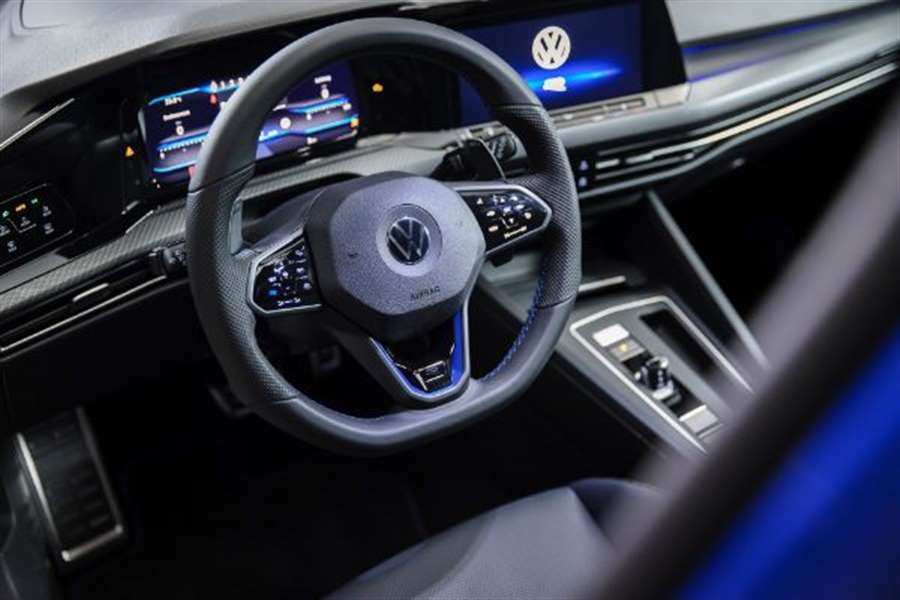
The Golf R can accelerate from 0-100 km / h in 4.7 seconds and reach a top speed of 250 km / h.
Sporty features extend beyond the engine compartment as well, as the Golf R has a sporty tuned trap with stiffer springs and protective bars. Engineers also added a lightweight aluminum subframe and increased the negative cam on the front axle to allow for higher cornering speeds as well as greater stability. The changes also improve the look of the car as the Golf R stands 20mm lower than the standard model.
In addition to the above-mentioned changes, the model has a modified adaptive damping system, electronic differential locks and a variable ratio control system. Drivers can also choose from six different driving modes, including Comfort, Sport, Race and Individual.
They were joined by two new settings called Special and Drift. Special mode is optimized and has softer damping settings than Race mode to "maintain maximum contact with the road". This helps the car deal with "wavy surfaces" on the road.
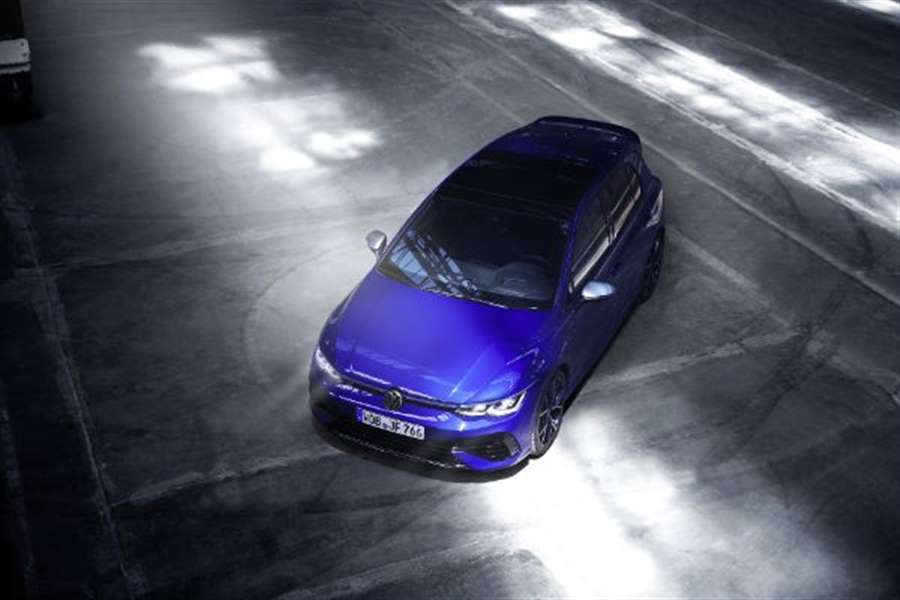
Leaving aside the performance characteristics, the Golf R has a sporty front bumper with unique air intakes and glossy black accents. The model also features a unique grille with a blue crossbar that glows as soon as the engine starts.
There are also sports side panels, matte chrome exterior mirror covers and 19-inch aluminum wheels wrapped in high-performance summer tires.
In the interior, customers will find Nappa leather sports seats with blue accents and R logos on the backs. The designers also gave the model an artificial carbon fiber lining, stainless steel pedal covers and a multifunctional sports steering wheel. Other beauties include a digital instrument panel and a 10-inch entertainment system.
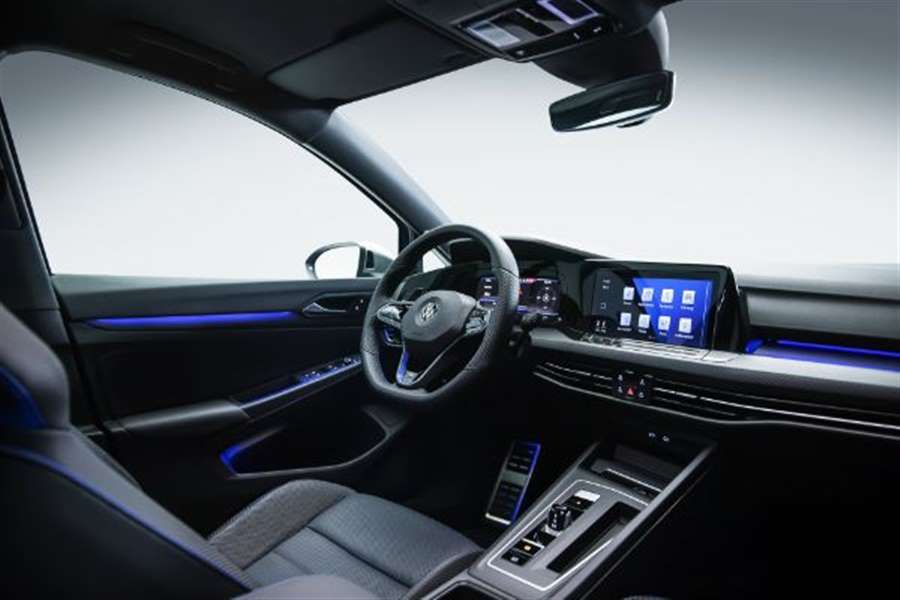
New Porsche Boxster GTS 4.0 PDK review
Can you have more fun for £70,000 than you do in the new Porsche Boxster GTS PDK? We think not.
Verdict
Even faster than its manual sibling, the Boxster GTS 4.0 PDK is one of Porsche’s most usable, fun cars. It feels perfectly sized for British roads and handles superbly, and the dual-clutch automatic gearbox doesn’t take away an emotional appeal that the regular four-cylinder Boxster simply cannot match. With near-supercar performance and a well-finished cabin, this car looks a bargain, even at just under £70,000.
We were totally bowled over by the Porsche 718 Boxster GTS 4.0 when we tried the flagship roadster with a manual-transmission earlier this year. Now it’s time to try the version which appeals less to purists but may well sell in greater numbers: the 718 Boxster GTS 4.0 PDK.
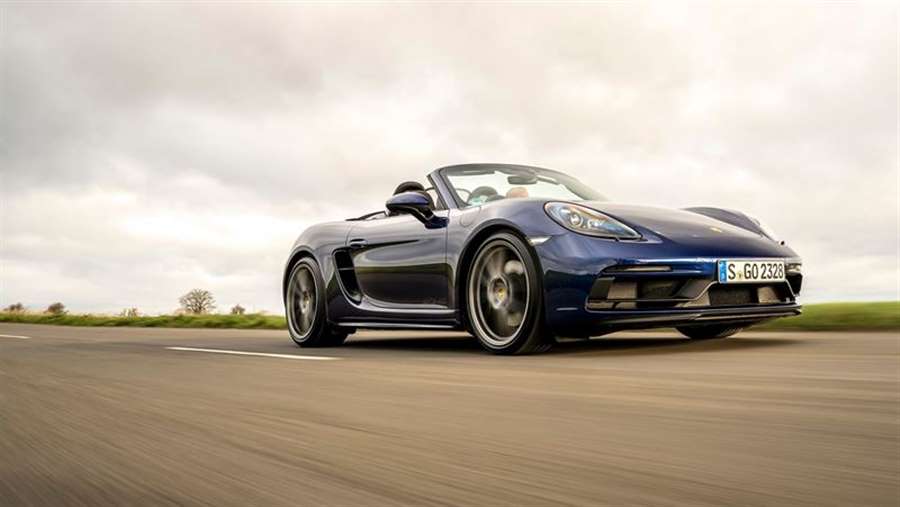
Slotting the seven-speed dual-clutch transmission into the range-topping variant of its entry-level convertible might look a brave move on Porsche’s part - not least because it’s going to want more money for it (the car costs £68,643, a premium of £2,303 over the manual). But it not only opens up extra potential sales; it also creates a little extra wriggle room on the engineering front.
That’s because the PDK transmission is able to deal with a little more shove than the manual - and Porsche has, conveniently, passed this gain on to the consumer. So while the basic power output remains the same as the GTS 4.0 manual, at 395bhp, you get 430Nm of torque instead of 400Nm. And as a result, the fast-shifting auto is even quicker - by a full half a second, in fact, from 0-62mph, at just 3.8 seconds. Let’s stop for a moment and just acknowledge that figure: a Boxster that’s sub-four seconds from 0-62mph.
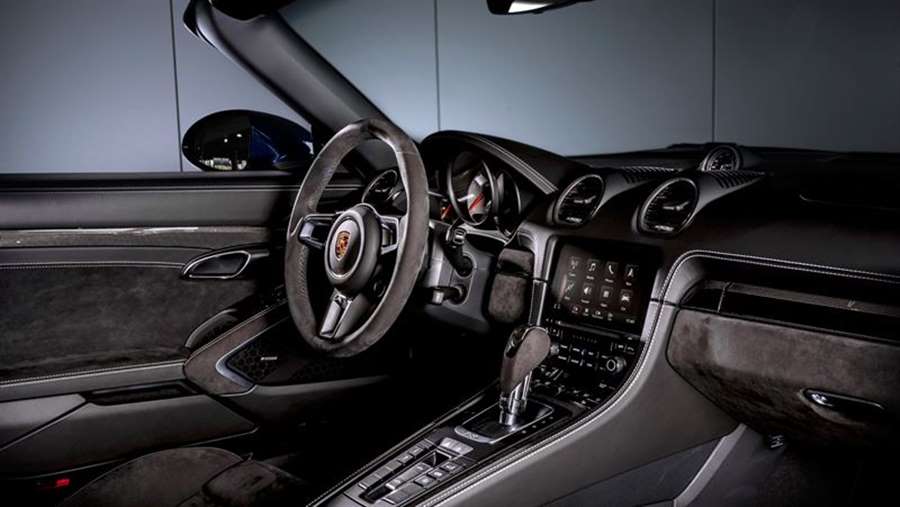
At this point you may be expecting us to start chipping away at the PDK experience by stressing the fact that it’s not as involving as the Boxster manual. Of course it can’t quite match the experience of the six-speeder. But that doesn’t mean it ever feels inferior; find the right stretch of road and this remains one of the standout models in Porsche’s (very strong) line-up.
The powertrain is so smooth and linear, in fact, that at first you may miss the absence of the sort of kick in the kidneys that you get when a turbocharger spools up. But then you’ll look down and realise that, with the revs rising towards the heady peak power delivery point of around 5,000rpm, you are, in fact, gathering velocity at a shocking rate of knots.
The GTS spec gets a sports exhaust as standard and it works beautifully with the six-cylinder engine, delivering a booming note from around 4,000rpm and then a proper scream once it’s really on song 1,000rpm later. It’s intoxicating - and while you may miss the ability to heel and toe to your heart’s content, believe us when we say that over a deserted stretch of road, you won’t find yourself feeling anything less than fully occupied in the PDK.
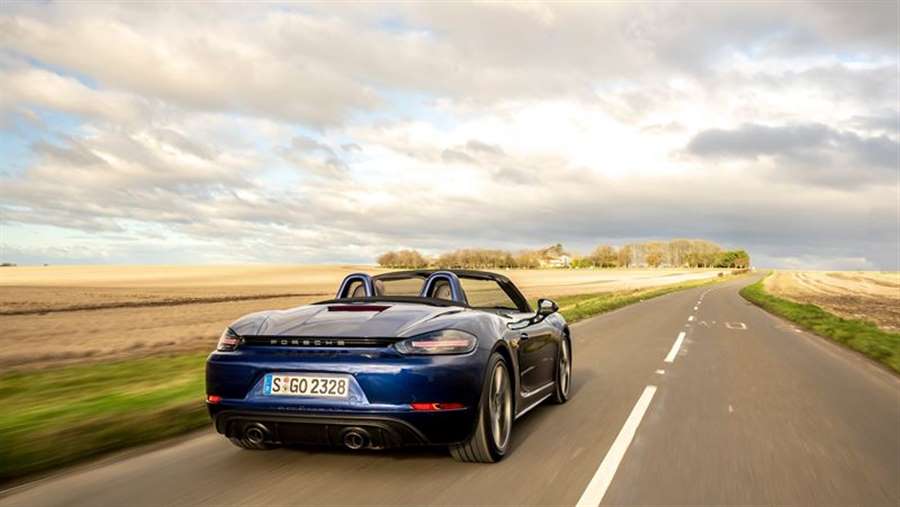
This car is about much more than its engine, too. The Boxster’s chassis has always been nicely judged and the adjustments to cope with the extra power have not played around with that, so you get a roadster that phases out the worst road imperfections, responds instantly to inputs through the satisfyingly weighty steering, and stays incredibly flat mid-corner, with exceptional control that belies its open-topped body.
If you do want to cover long distances in your GTS, then, you’ll find that it has that incredible duality that the best Porsche models usually possess - so it’ll cruise along in comfort, with only tyre roar (possibly the car’s biggest flaw) and a little bit of wind noise from around the roof seal at the A-pillar to complain about.
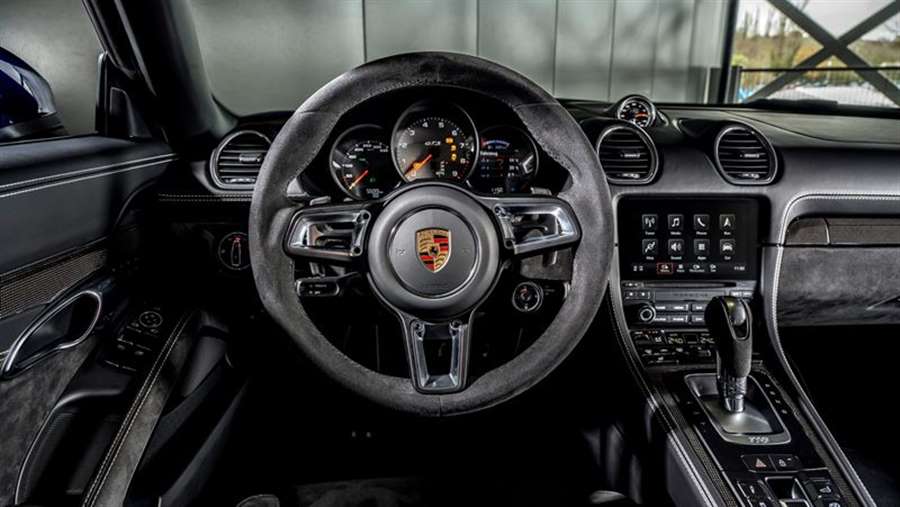
The cabin is beautifully finished and, by Porsche standards, well equipped as standard - although of course, there remains huge scope to add thousands of pounds to your price tag via the comprehensive options list (our German-spec, left-hand-drive test vehicle was taken to a cool €105,000). The fascia layout still feels reassuringly driver focused, although the infotainment system is now firmly eclipsed by what you can get in a 911 - and it’s worth noting that Porsche only supports Apple smartphone connectivity; Android Auto isn’t even an option.
Source: autoexpress.co.uk
2021 Ferrari Roma: The Beauty of 612 Horsepower
Ferrari builds a modern GT without relying on the design tropes of the past.
The Ferrari Roma's start button isn't a button. It's an iPad-like touch-sensitive switch at the bottom of the steering wheel. And it's but one of many functions crammed onto the helm. Even after spending 30 hours with the car, we were still uncovering new ones. Ferrari isn't relying on its heritage here. This is only the second V-8-powered front-engine GT coupe in the brand's history—the first being the 2018 GTC4Lusso T, which was the refreshed FF with four fewer cylinders. No, with the Roma, Ferrari focused on making a 21st-century grand-touring car with an almost all-digital interface and without a goofy retractable roof.
Sure, the hardtop convertible Portofino is still around, and there's a lot of Portofino in the Roma, but the Roma is some 200 pounds lighter and 20 horses more powerful, with a 612-hp version of Ferrari's twin-turbo 3.9-liter V-8. The upcoming Portofino M will match that output, but it won't rectify the weight discrepancy. And while all three of these Ferraris have an engine that roars like artillery, the Roma is prettiest.
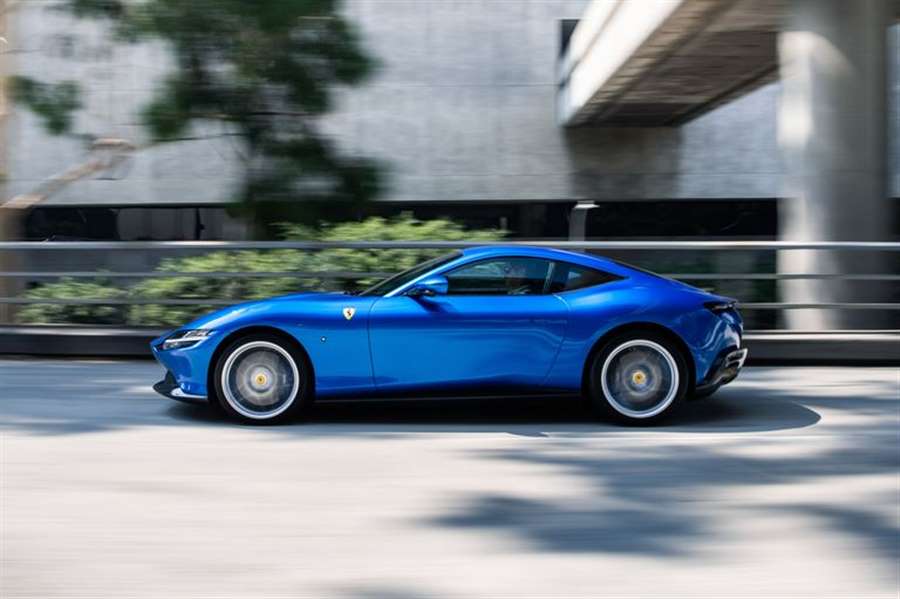
It has the face of a shark. The fenders flare like a Sophia Loren sigh, and the bodywork is free of holes, vents, and gouges. The razor-edge taillights look nothing like the usual round Ferrari fare. The Roma and Portofino share a 105.1-inch wheelbase and their basic suspension design, but the Roma is 0.7 inch lower, 1.4 inches wider, and at 183.3 inches long, 2.7 inches longer overall.
The 561-lb-ft torque peak comes up at 3000 rpm and stays there until 5750 rpm, with plenty beyond that to the 7500-rpm redline. Pop the hood and the Ferrari V-8 looks as good as the body. There's no plastic sound-insulation cover here.
Read more: 2023 Ferrari Dino
Pull the right carbon-fiber paddle shifter and the rear-mounted, Magna-made eight-speed dual-clutch transaxle loads first gear. The Roma is the first of Ferrari's GTs to include a Race setting for the stability and traction-control system. Turn the manettino selector on the steering wheel to Race and the car growls and gets down to the business of ground flying.
Shifted with the paddles, the eight-speed reacts instantly. Downshift into a corner and the car squats flatly, takes a set at the apex, and bolts confidently. The system allows a bit of tail slide, but on public roads, it's hard to get to the cornering velocity where the 285/35ZR-20 Michelin Pilot Sport 4S tires will break free. What's available even in Comfort mode is perfectly calibrated steering and the thrill of feeling the 245/35ZR-20 Michelins up front bite into the surface.
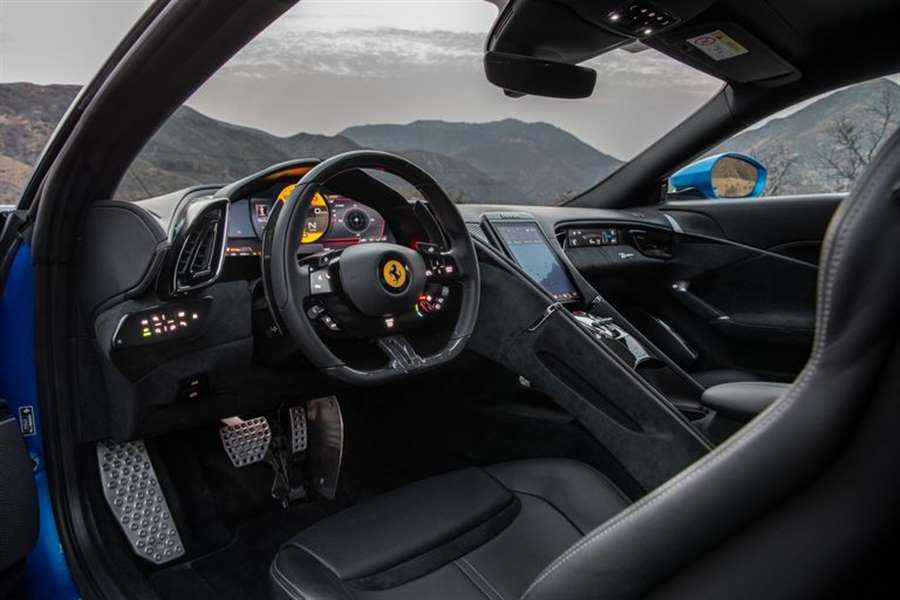
We expect this Ferrari to eclipse 60 mph in 3.1 seconds when launch mode is activated, but the exhaust drama and pull of the engine make it seem even quicker than that. And the Roma is beguiling at triple-digit speeds. It also has a hilarious rear seat and a reasonably sized 10-cubic-foot trunk.
Roma prices start at $222,420. The version driven here carried an option load that put it at $316,240. Skip the $11,812 carbon-fiber rear diffuser, the $5906 front spoiler you're bound to scratch, the $4725 carbon-fiber dashboard inserts, and a few other bits, and a Roma could be a great quarter-million-dollar Ferrari. In the prancing-horse world, that's a bargain.
Source: caranddriver.com


